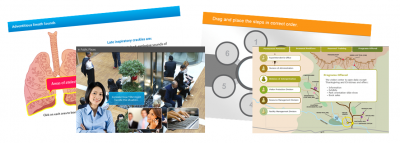There are many times when you have various concepts or “chunks” of information on a single slide. This information can be broken down into engaging interactions which involve interfaces that allow the learner to view and interact with what they see on the screen. This month we bring to you a few ways to add interactivity in your courses.
Interactive Content
Learning does not have to be boring, flat, or a chore for the learner to complete! Adding interactions throughout the module allows the learner to stay engaged and participate by making them think and make choices. The learner can click a spot on the screen to reveal more information, take in bite-sized information, and then click the next area to learn more.
Interactive Scenarios
When the information you’re presenting needs to be explored in greater depth, scenarios can be a useful choice of interaction. Scenarios allow the learner to gain knowledge on how to respond to relevant or work related situations by placing themselves in that specific setting. The learner can view a scenario and make decisions based on the given situation. Use of characters, appropriate background, speech bubbles, and audio, makes the scenario appear more real.
Tabbed Interactions
Tabs are a handy navigational tool to make use of sharing multiple pages of information with the learner. As each tab is clicked, it brings up a corresponding slide of information. Each slide covers a general topic and the tab is titled accordingly. This is a great way to minimize the number of slides in your course to make it appear shorter and less overwhelming for the learner.
Learning Games
Why not make your course both fun and educational? Dull subject matter can also be turned into an engaging and exciting learning experience. Games such as Jeopardy, Millionaire, or Hangman can be added to engage the learners. Games give learners the power to control and achieve better by giving them choices. By having the right amount of challenges and levels you can keep the learner’s attention. With appropriate planning and storyboarding, gaming can be highly effective and impactful for a diverse audience.
Interactions Using Hotspots
Hotspots are shapes that are placed on an image or any other area on the screen, and made clickable. These can be invisible, and when the learner hovers over an effect or information is displayed. Multiple hotspots can be placed on a single image and each one can be clickable. Hotspots can also be used on a video.
Drag and Drop Interactions
Drag and drop interactions can make a dull module entertaining, which means greater retention. The learner moves an object from one point to another. For example, if there were several steps in a process and the learner was required to learn each step, they can drag and drop each step in correct order. Drag and drop can also be used to sort information into specific categories, or match a term to its definition.
There are several ways to create interactive content within your eLearning course. Brookwood offers a variety of complex interactions among our many eLearning design and development services. For more details on our specific services visit: Brookwood.com.

